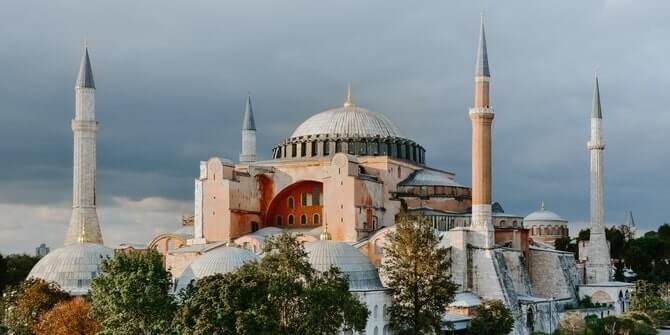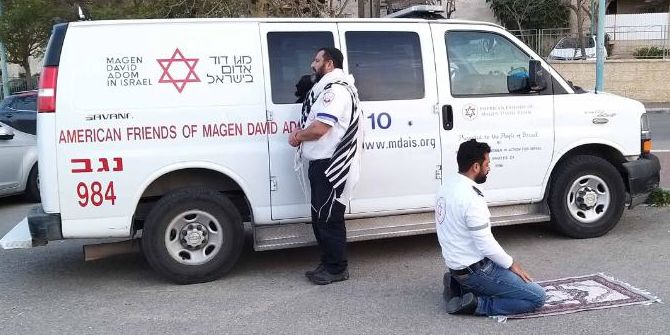President Erdoğan’s decision to reclassify Hagia Sophia as a mosque is one of the more dramatic examples of the return of religious prominence in our postsecular era. The great building has had a tumultuous history, as a church, a mosque and recently a secular museum that preserved religious history but did not allow for worship. Though the ‘clash of civilisations’ narrative will have traction in this time of populist posturing, James Walters considers how such a development places new demands on interreligious cooperation. With the Hagia Sophia no longer a secular space, will Turkey’s political and religious leaders ensure that Christians can continue to visit and feel welcome in this sacred space?

It is easy to interpret the current furore around Istanbul’s greatest building within the narrative of a clash of civilisations. For nearly a thousand years, the Church of the Holy Wisdom (Hagia Sophia in Greek, Ayasofya in Turkish) was the ultimate icon of Christian civilisation. Built as the jewel in the crown of Constantinople, a city named after the first Christian emperor, it symbolised Christianity’s transition from messianic radicalism to the life-blood of a whole social, political and cultural order. When Emperor Justinian completed work on the church he compared it to the great temple in Jerusalem allegedly proclaiming, “Solomon, I have surpassed thee.”
The comparison was apt. A building like this is not just another place of worship. It represents what lies at the heart of a collective identity. As the Ark of the Covenant rested in the sanctuary of the Temple in Jerusalem, so the original Church of Hagia Sophia housed a relic of the cross of Christ, a sign of the new Christian covenant and the sign by which Emperor Constantine was told, in his famous vision, that he would conquer.
Little wonder then that the conversion of Hagia Sophia into a mosque after the Ottoman conquest in 1453 provoked a trauma not dissimilar to that felt by the Jews after the siege of Jerusalem in AD 70. This was particularly true for the Greek Orthodox, but even the Western Church (which had itself attacked the city in 1204!) retained a nostalgic sadness at Constantinople’s fall to Islam. Christianity was not eradicated from this part of the world; Christians were granted land and second-class citizen status. But the surrender of their “Great Church” created a sense of loss and dispossession that endures in large sections of world Christianity to the present day.
President Erdoğan’s politically motivated decision to restore Muslim worship to the Ayasofya has inevitably, therefore, been received with strong emotion. Pope Francis has spoken of his sadness while the Eastern Churches have been less reserved; Archbishop Ieronymos of Athens branded the move “an insult and injury to all civilised humanity.” For Christian minorities in the region and for countries like neighbouring Christian Armenia, still bearing the scars of an unacknowledged genocide and facing renewed interreligious conflict over Nagorno-Karabakh, it is a menacing move. Ancient civilizational clashes reverberate within contemporary hostilities.
Yet, of course, what President Erdoğan has reversed in this decision is not the building’s Christian status but that of a secular museum. The Christian sense of dispossession from this site has been rekindled but it is not new. Neither Christian nor Muslim worship has taken place in Ayasofya since 1935 when Turkey’s secularist ‘moderniser’ Mustafa Kemal Atatürk’s response to ancient religious conflict was to brand all religion superstitious, backward and decadent. That popular sentiment is directed more at overturning this secularist suppression than a clash with Christian civilisation was borne out in the sermon preached at the first Friday prayers since worship resumed which has been accused of directly attacking Atatürk. Under his direction the powerful sacred symbolism of this building was tamed in conformity to that most modern and neutral of spaces, the museum, in which none may pray but all may learn. This brought the benefit of making both Christian and Muslim heritage equally accessible to all visitors. Yet as with all museums, no one could prostrate or venerate, and this is a building which so many believe demands precisely that.
So Erdoğan’s decision may be lamentable, but it was perhaps inevitable. It is symptomatic of the broader collapse of supposedly neutral secular arrangements in response to the challenges of religious difference. Forcing women to strip off their burkinis on French beaches or dogmatically imposing a progressive sex education on communities to whom it is anathema in British schools are relatively trivial examples of the inadequacy of faith-hostile policymakers in dealing with the complexities of today’s globalised religious pluralism. From India to the US, China to Europe, the modern notion of a religiously neutral state holding diverse groups together through the relegation of religion to the private sphere is falling apart at the seams.
If Erdoğan’s decision was, at some point, inevitable it is now almost certainly irreversible. The global political climate suggests that Ayasofya’s Christian significance will not be restored by a triumphant reassertion of secular liberal values. What is needed therefore is a concerted coming together of religious communities themselves to broker the kind of mutual respect they wish to see. Erdoğan is insistent that his decision is in the interests of all religions, but that is a claim that needs to be made real. If the secular can no longer arbitrate, it is imperative that religious groups show each other hospitality, in this case recognising that some Christians will want to visit this mosque not just as tourists but as some kind of pilgrim. The experience of the mosque-turned-cathedral at Cordoba in Spain suggests that sharing such spaces devotionally is unrealistic. But it must be possible to find ways in which the common heritage of these buildings can be celebrated as architectural expressions of the shared stories and holy figures of Christianity and Islam themselves.
Such a vision of responding to the civilizational clashes of history with hospitality and dialogue may be optimistic. For all the hopeful interfaith initiatives around the world there is much territorial sectarianism suspicious of religious plurality. But as the secular solutions of modernity fall away, the alternative is bleak. The greatest danger of Samuel Huntington’s thesis was always that talk of an escalating clash of civilisations would become a self-fulfilling prophecy. Avoiding it may be among our most urgent tasks.
Note: This piece gives the views of the author(s), and not the position of the LSE Religion and Global Society blog, nor of the London School of Economics.






Fr. James’ views show an understanding of the modern challenge to people of all religious dispositions (or none), to love God, your Neighbor, and Yourself.